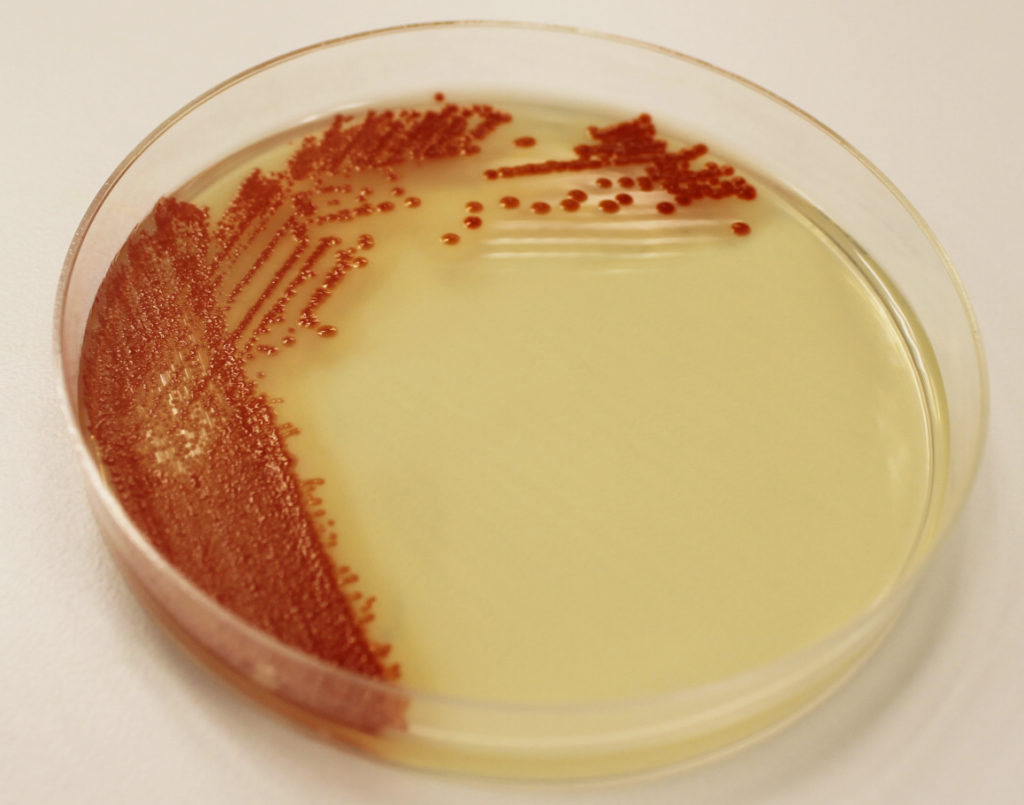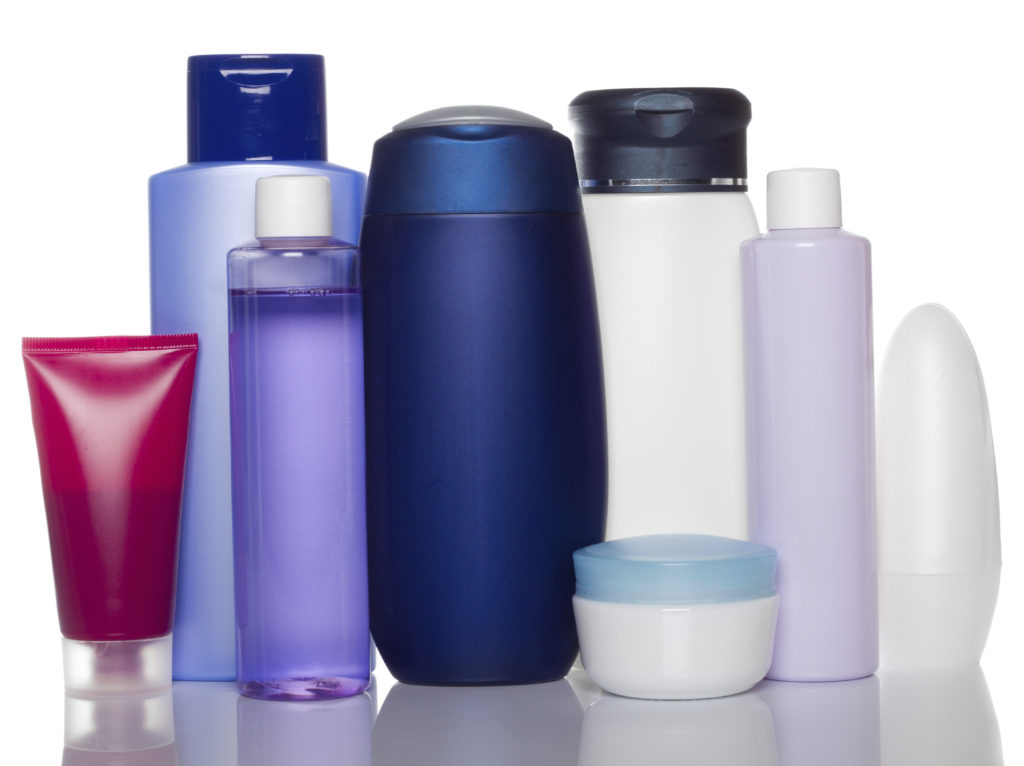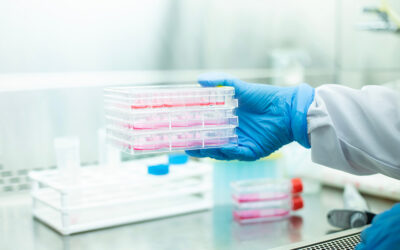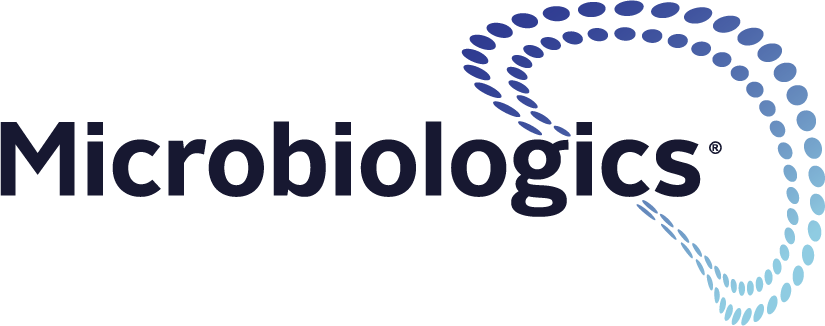In 1950, a United States Navy ship spent six days spraying Serratia marcescens into the air two miles off the coast of San Francisco. The spraying was part of a biological weapon test called Operation Sea Spray. Prior to the 1950s, S. marcescens was considered to be a harmless saprophyte.
The microorganism was chosen as a surrogate for a more deadly bacterium like Bacillus anthracis because it is found in soil and produces a red pigment that makes it easily traceable. Unfortunately, a week after the spraying, 11 residents checked into Stanford University Hospital with urinary tract infections caused by S. marcescens.
The 1950 incident was the first recorded outbreak of S. marcescens. Since that time, S. marcescens has become recognized as an important opportunistic pathogen by the health care and pharmaceutical industries.
Appearance: Gram negative, facultatively anaerobic rods. S. marcescens is motile by means of peritrichous flagella.
Conditions for Growth: S. marcescens will grow at 20°C and 40°C, pH 9 and in 4% NaCl.
Isolation: Selective agars such as MacConkey and CHROMagar can be used to isolate S. marcescens from non-sterile or environmental sites.
 Pigment Production: S. marcescens, biogroups A1 and A2/6, produce a red pigment called prodigiosin. As a result they form pink or red colonies on nutrient agar. Other biogroups of S. marcescens (A3, A4 and A5/8) do not produce the pigment.
Pigment Production: S. marcescens, biogroups A1 and A2/6, produce a red pigment called prodigiosin. As a result they form pink or red colonies on nutrient agar. Other biogroups of S. marcescens (A3, A4 and A5/8) do not produce the pigment.
Habitat: S. marcescens has been isolated from small mammals (such as rodents), water, plants, vegetables used in salads, diseased honey bees, and hospitalized patients.
Family: Serratia marcescens belongs to the Class, Gamma Proteobacteria; Order, Enterobacteriales, Family, Enterbacteriaceae; Genus, Serratia; Species, marcescens.
Pathogenicity: S. marcescens is an opportunistic and nosocomial/health care pathogen. Most at risk for infection are debilitated or immunocompromised individuals. S. marcescens has caused respiratory tract infections, urinary tract infections, colonization of indwelling catheters, surgical wound infections, septicemia, and contact lens-induced acute red eye.

Sources of Infection: One source of infection is patient to patient. A second source is contaminated equipment such as nebulizers and tubing. Contaminated fluids such as irrigation fluid, antiseptic solution, hand wash, shampoo and contact lens solution can also cause infection.
Contamination can be intrinsic or extrinsic. An example of intrinsic contamination is an outbreak in King Abdulaziz University Hospital in Saudi Arabia which was traced to locally manufactured shampoo. An example of extrinsic contamination is described in a study which found one in four public restroom bulk-soap-refillable dispensers are contaminated with bacteria such as S. marcescens.
Newborns: Newborns are susceptible to colonization by S. marcescens. Soiled diapers may show a red discoloration (red diaper syndrome).
Recalled Contaminated Products:
- 1993: Blood transfusion bags
- 2005: Shampoo caps with conditioner
- 2008: Heparin and saline pre-filled flush syringes
- 2009: Baby shampoo
- 2011: Total Parenteral Nutrition (TPN), a liquid nutrition fed through an IV using a catheter
- 2012: Bath milk for babies
Resistance to Antimicrobials and Disinfectants: During the past 40 years, S. marcescens has shown an ability to become resistant to antimicrobials such as gentamicin and fluoroquinolone. Some strains are positive for extended spectrum beta-lactamase (ESBL). An outbreak of S. marcescens infection in a neonatal intensive care unit was traced to contaminated soap containing 1% chloroxylenol, a preservative used in antimicrobial soaps.
Looking for S. marcescens controls? Follow this link to find the right strain and format for your lab.
Want to learn more? Check out these references:
Abbot, S. (2007) Klebsiella, Enterobacter, Citrobacter, Serratia, Plesiomonas, and Other Enterobacteraciae. In Manual of Clinical Microbiology (10th ed., Vol. 1, pp. 403-408). Washington, DC: ASM Press.
Alsaedi, S., et al. (2011) Serratia marcescens-contaminated baby shampoo causing an outbreak among newborns at King Abdulaziz University Hospital, Jeddah, Saudi Arabia. Journal of Hospital Infection. 28(2011) 16-19
Grimont, F. and Grimont P. (2006) The Genus Serratia. Prokaryotes: Chapter 3.3.11. 219-244
Herra, C., Falkiner, F. Serratia marcescens. Antimicrobe. Infectious Diseases & Antimicrobial Agents. http://www.antimicrobe.org/index.asp
Heltberg, O., et al. Nosocomial epidemic of Serratia macescens septicemia ascribed to contaminated blood transfusion bags. Transfusion. 1993 Mar; 33(3):221-7.
Kreston, R. (2015) Blood & Fog: the Military’s Germ Warfare Tests in San Francisco. Body Horrors.
Neza, E. and Centini, M. (2016) Microbiologically Contaminated and Over-Preserved Cosmetic Products According Rapex 2008-2014. Cosmetics. 2016, 3.3. www.mpi,com/journal/cosmetics.
Parenteral Drug Association (PDA). (2014) Technical Report No. 67. Exclusion of Objectionable Microorganisms from Nonsterile Pharmaceuticals, Medical Devices, and Cosmetics. www.pda.com
Parment, A. (1997) The role of Serratia marcescens in soft contact lens associated ocular infections. Acta Opthalmol. Scand. 1997:75:67-71.
Thompson, Helen. (2015) In 1950, the U.S. Released a Bioweapon in San Francisco. Smithsonian. July 6, 2015. www.smithsonian.com
UL-ICQ. (2012) Bath Milk for Babies – Microbiological Risk.
U.S. Food and Drug Administration. (2005) Voluntary Recall of Shampoo Caps
U.S. Food and Drug Administration. (2008) FDA Warns Public of Contaminated Syringes.
Weber, D.J., Rutala, W.A., and Sickbert-Bennett, E.E. (2007) Outbreaks associated with Contaminated Antiseptics and Disinfectants. ASM. Antimicrob. Agents Chemother. December 2007 vol. 51 mp 12 4217-4224.
Zapka, C., et al. (2011) Bacterial Hand Contamination and Transfer after Use of Contaminated Bulk-Soap-Refillable Dispensers. Appl Environ Microbiol. 2011 May, 77(9): 2898-2904.






Dear Colleague, I appreciate you for this article , and I ‘d like to know what are the standard method for sample collection and what are the updated biochemical identification tests for this organism
Samples should be collected in accordance with your facilities established protocol. For instance, if your facility is a hospital or clinic, the sample would be collected from the site (whether it is a wound or a urine sample) by trained personnel, per their customary procedures. Or, if your facility is a municipal water treatment plant, you would collect samples in accordance with your regulatory agency (such as EPA or Standard methods).
Here are two references that address the biochemical responses of this strain.
1. Wiley Online Library: http://onlinelibrary.wiley.com/doi/10.1002/9781118960608.gbm01167/abstract
2. The Genus Serratia: https://ic.ucsc.edu/~saltikov/bio119l/readings/prokaryotes/Serratia.pdf
Thanks for sharing this information, I really appreciate the content you have described and the helpful information you gave us about environmental isolation. It’s treatment is very important. Learned a lot from this.
Environmental Fluids
Very nice and informative post! This is very important incident we all should have known about. You are spreading information about this topic that’s really a great deal.
Environmental Fluids
Nice Blog!!!!And this may helpful for lot of peoples. I know you always do a great job but today you uploading all good benefits blogs.So you are provided such a nice and great article within this.
Environmental Fluids